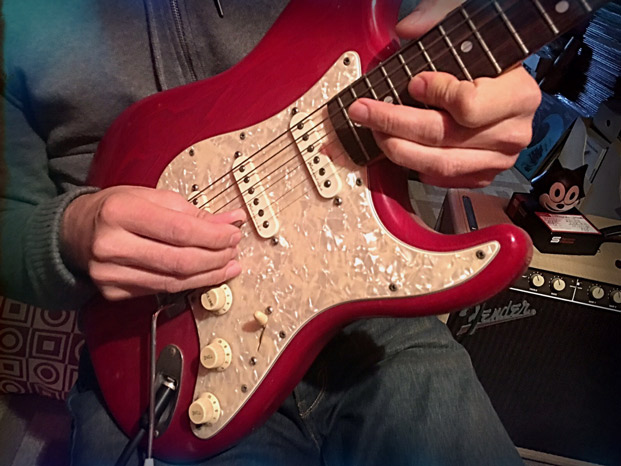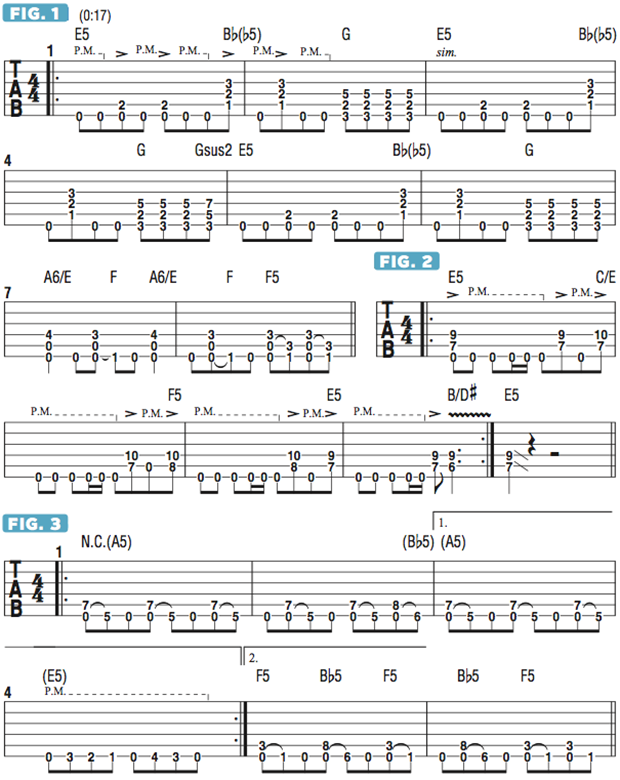How to Inject Unusual, Jarring Chord Voicings into Metal Rhythm Guitar Parts
Dress up your riff ideas with murky, monstrous-sounding, aggressively attacked chord figures and patterns.

One of the essential qualities of a great metal riff is the presence of a signature element—unusual chord voicings, a twisted melodic line—that immediately grabs your attention.
In this column, I’d like to demonstrate a few ways to achieve this and dress up your riff ideas with murky, monstrous-sounding, aggressively attacked chord figures and patterns.
FIGURE 1 is played in a rhythm of steady, hard-driving eighth notes, for which the open low E string is used as a palm-muted pedal tone throughout. In bar 1, two-note E5 power chords are accented on the downbeats of beats two and three, but at the end of the bar, I switch to upbeat accents of Bb(b5) on the upbeats of beat four and beat one of bar 2.
Bar 2 then ends with an unusual voicing of G. This is all repeated across bars 3 and 4, except for one twist: at the end of bar 4, I add a single accent on a prog-style “spread” voicing of Gsus2. Bars 5 and 6 are a recap of bars 1 and 2, and then the figure ends in the last two bars with the bottom two open strings played in conjunction with hammer-ons with the fret-hand index and ring fingers.
These final chords have an atonal quality and, when struck aggressively, impart an “angry” and “edgy” sound. With FIGURE 2, my goal was to inject a lot of melody into a guitar part via a succession of moving two-note chord voicings. Once again, the voicings are played against a palm-muted, open low E-string pedal tone.
And as in FIGURE 1, I begin by accenting the downbeats but then switch immediately to upbeat accents, such as on the chords E5, C/E, F5 and B/D# played later in the progression. Most of the melodic content in this rhythm part is supplied by the notes that fall on the D string, which is the highest string used in the figure. In bar 4, the melodic element shifts to the A string, as the E root note moves down a half step to D#, the major third of B, resulting in a two-note B/D# voicing.
Additional rhythmic drive is provided by the “gallop” rhythm—an eighth note followed by two 16ths—played on the low-E pedal tone on beat two of each bar. It can at first be a bit tricky getting used to dropping this gallop rhythm into the part at precisely the right moment, so start out slowly and gradually build up speed once you fix the pattern into your muscle and auditory memory. For our final example, FIGURE 3, I was looking to create a “grinding” sound via the use of repeated hammer-ons into A5 and Bb5 power chords.
All the latest guitar news, interviews, lessons, reviews, deals and more, direct to your inbox!
With my ring finger fretting notes on the A string, I repeatedly hammer from the open low E string to either the fifth or sixth fret with my index finger. In bar 4, I interject a chromatically descending line on the low E string, and at the very end of the phrase, I switch to hammer-ons into an F5 power chord. Be sure to attack the strings aggressively with the pick throughout, striving to accentuate the high-frequency harmonics in the notes on the bottom two strings.

